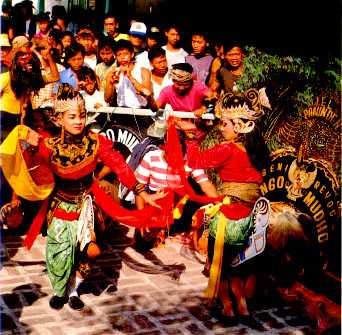
TRAVEL NOTES
 It
was at the gong shop that we learned two things. The first was
that if we were really serious about buying good gamelan instruments,
including best quality gongs, we should go to Magetan. The other
exciting news was that a reog performance was at that very moment
going on in Ponorogo. Without delay, therefore, we hastily piled
the gongs on top of our increasing baggage and sped off in the
direction of the town. It
was at the gong shop that we learned two things. The first was
that if we were really serious about buying good gamelan instruments,
including best quality gongs, we should go to Magetan. The other
exciting news was that a reog performance was at that very moment
going on in Ponorogo. Without delay, therefore, we hastily piled
the gongs on top of our increasing baggage and sped off in the
direction of the town.
We arrived as the procession, which included two Singa barong
masks, was coming down the main street, accompanied by a wild
and noisy crowd. Traffic was diverted as the dancers stopped
in the middle of the road to perform. We got out of the car and
were immediately welcomed by the onlookers, who insisted that
we join in the spirit of the occasion by offering us opened bottles
of local arak, a powerful liquor with a flavour not unlike schnapps.
Arak, we were told, is an essential ingredient in a traditional
reog performance, since it gives strength and daring (keberanian)
to the performers as well as increases the frenzy of the audience.
According to local belief, the reog of Ponorogo dates back to
the pre-Islamic Javanese kingdom of Kediri, specifically to the
reign of King Jayabhaya, who is said to have created the dance
during the first half of the 12th century. The reog performance
re-enacts a battle between Pujangga Anom, a minister from the
court of Ponorogo, and Singa barong, ruler of the forest of Lodaya.
A legend recounts how a king of Ponorogo wished to marry a princess
from Kediri. As a dowry, he ordered one of his ministers, Pujangga
Anom, to take 150 tigers from the forest of Lodaya and present
them to the king of Kediri. The theft of so many tigers, however,
aroused the anger of Singha barong, guardian spirit of Lodaya,
who confronted Pujangga Anom in a terrific form, accompanied
by his two assistants and sources of spiritual strength, the
tiger and the peacock.
A typical reog troupe, then, usually consists of the two principal
characters; Singa barong, wearing the enormous tiger head and
peacock feather mask, and his masked adversary Pujangga Anom.
They are accompanied by one or more masked clowns/acrobats, as
well as a number of hobby horse (jaran kepang) dancers, who are
said to represent the troops of Pujangga Anom. The reog dance
has been compared with the barong of Bali as well as the Chinese
Lion Dance, in attempts to trace its origins. Wherever these
may lie, the reog, to the Javanese, is immediately associated
with Ponorogo. The people here have a reputation for being tough,
both physically and mentally, a quality inherited from centuries
of living in a harsh environment, where it was often difficult
to obtainwater and where the surrounding forests were full of
dangerous animals. This toughness, the qualities of bravery and
daring, are fully displayed in a reog performance, where the
focus of attention is on a trance dancer supporting a giant mask,
often weighing more than 40 kgs, between his teeth. The mask
is a ferocious, snarling tiger's head, covered in real tiger
skin and crowned with a gigantic three metre fan of peacock feathers.
The success of a performance, including the ability of the principal
dancer to bear the weight of the mask, is said to depend upon
the magical power of the leader of the troupe of dancers and
musicians.
|
